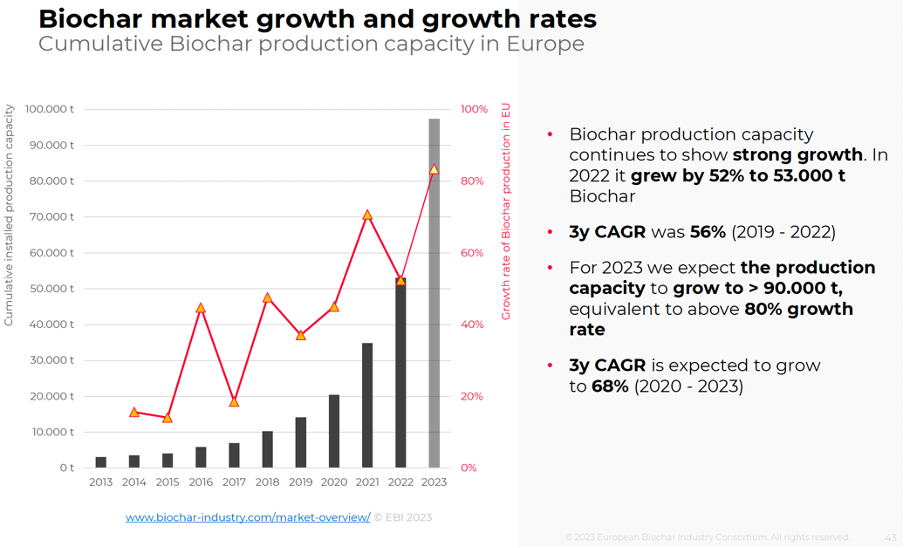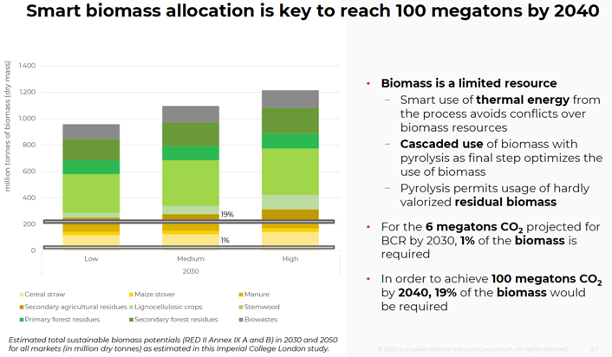Biochar-based Carbon Sequestration: Opportunities, Challenges and the Way Forward – by David Kesner
Biochar is a carbon-rich material produced by heating biomass in an environment with limited oxygen[1]. This process locks atmospheric carbon into a chemically inactive form, thereby contributing to climate change mitigation. Biochar is arguably the most readily scalable carbon sequestration technology as it can be made with relatively low material and capital input from a wide range of biogenic wastes. Some of its benefits are:
- when amended to cropland soils, it has been shown to increase soil carbon pools by 95% above the amount of carbon that it introduces directly[2]
- it is estimated that 97% of its carbon content persists in soil for an average duration of 556 years[3,4]
- it can reduce enteric methane emissions from livestock when used as a feed supplement[5] and reduce ammonia emissions when amended to excrement and composting piles[6]
- it has been shown to reduce soil N2O emissions by 38% on average[7], which is notable considering N2O has ~300 times the heating effect of the equivalent mass of CO2 over a 100-year period
- it increases soil water and nutrient holding capacity, leading to crop yield and tree growth-rate increases[3,6,8,9].
Biochar can therefore be a valuable tool for reducing harmful agricultural emissions, increasing food production, and catalysing afforestation and reforestation efforts.
Verification of biochar-based carbon sinks
Despite its many benefits, biochar-based carbon removal faces a few key challenges. Without controlled combustion of the gaseous emissions from its production, it can be a net contributor to global heating due to excessive methane production[10]. Secondly, the global heating benefit of biochar depends on the baseline scenario that it modifies: if agricultural waste biomass is used, which in many parts of the world is burned to ash in open fields, biochar production is likely to be carbon negative. However, its climate benefit is compromised if biomass that is otherwise part of a natural carbon sink is used. Therefore, to ensure that the benefits of biochar are realised, it is crucial to establish a strong certification industry supporting the issuance of biochar-based carbon credits.
Recent developments in the carbon credit industry have advanced the compliance infrastructure for biochar-based carbon removal. In 2022, Carbon Standards International, a developer of standards for climate-neutral industry and agriculture, released guidelines for the certification of artisanal biochar-based carbon sinks in developing countries[11]. This facilitates carbon credit access to resource-constrained biochar producers. In the same year, Verra, the world’s leading carbon credit verifier, issued a methodology that provides a framework for quantifying greenhouse gas benefits and hence redeemable carbon credits from biochar production[12]. This is the first globally approved methodology for the utilization and application of biochar under Verra’s Verified Carbon Standard[13].
Controversy concerning Verra’s carbon credits has emerged recently, with the CEO of Verra resigning[14] after an investigation by The Guardian, Die Zeit, and SourceMaterial claimed that of 95 million carbon credits issued by Verra for forest projects, only 5.5 million (6%) represented real emissions reductions[15]. However, Sylvera, an independent carbon ratings agency, responded to the investigation claiming that it overstated the problem, highlighting its own findings that around 30% of forest credits are high quality, two-thirds are mixed quality, and 25% are worthless[16]. These developments might call into question the legitimacy of the carbon credit industry in general, which has traditionally been based on opaque processes that fail to provide market participants with granular detail on how credits are produced or their overall quality.
However, there is a growing industry trend towards increased transparency, accountability, and information accessibility, with independent credit risk rating agencies emerging in recent years that give buyers detailed third-party ratings of projects’ carbon efficacy and implementation risks. Furthermore, companies like Senken and Dovu track carbon credit information on fully transparent, publically available distributed ledgers. Such market developments act to deter investment in projects that issue worthless credits while providing more clarity on and accessibility to the voluntary carbon market, ultimately encouraging market participation.
The issuance of carbon credits from biochar production is inherently resilient to over-crediting (the issuance of more credits than tonnes of CO2 sequestered). Production is fast and simple, and carbon removals are permanent provided the biochar isn’t subsequently burned. This is favourable compared to projects with long wait times for carbon removals (e.g. afforestation projects that may take decades for forest carbon sinks to mature). Analysis by BeZero Carbon, a carbon credit risk rating agency, shows that biochar is the most technologically mature engineered carbon removal method available, as of May 2023 accounting for 89% of all engineered carbon removal credits retired in the history of the market[17].
The European biochar industry
The European biochar production and certification industry is well-developed. A 2023 market report from the European Biochar Industry Consortium[18] estimated that total European biochar production in 2022 achieved sequestration of more than 90,000 tonnes of CO2, expecting this to grow to up to 150,000 tonnes this year. This will continue an exponential growth trend over the past decade, which has been accompanied by growth in product certification[18]. Certification increased from under 50% of production capacity in 2018 to almost 70% estimated by the end of 2023[18]. The European Biochar Certificate is the most renowned certification and is an obligatory standard to meet in Switzerland for all biochar sold for use in agriculture[19].

Source: European Biochar Market Report 2022 | 2023[18].
The industry report claims that maintaining such production growth rates is feasible[18]. To achieve 6 megatons of CO2 removed by 2030 and 100 megatons by 2040, only 1 and 19% of the total sustainable biomass potential available across Europe from agriculture, forestry and biowastes will be needed respectively[18], highlighting the sizeable market opportunity for the biochar industry to scale.

Source: European Biochar Market Report 2022 | 2023[18].
In summary, biochar is a cost-effective and efficient carbon removal technology with the potential to reach climate-relevant levels in the next 15 years[18]. The key to scaling the industry is more regulatory and political support to develop more markets for its use[18]. The carbon credit market can incentivize upscaling of biochar production, and continued development of credit certifications and risk ratings as well as further expansion of credit purchase and tracking technologies will grow market visibility and ease of access.
About the Author
David Kesner BSc (Hons) MSc MPhil is a freelance environmental scientist.
Blog posts on the CIEEM website are the views and opinions of the author(s) credited. They do not necessarily represent the views or position of CIEEM. The CIEEM blog is intended to be a space in which we publish thought-provoking and discussion-stimulating articles. If you’d like to write a blog sharing your own experiences or views, we’d love to hear from you at SophieLowe@cieem.net.
References
- International Biochar Initiative. List of frequently asked questions. Published 2022. Accessed June 19, 2023. https://biochar-international.org/about-biochar/faqs/
- Blanco‐Canqui H, Laird DA, Heaton EA, Rathke S, Acharya BS. Soil carbon increased by twice the amount of biochar carbon applied after 6 years: Field evidence of negative priming. GCB Bioenergy. 2020;12(4):240-251. doi:10.1111/gcbb.12665
- Schmidt H, Kammann C, Hagemann N, et al. Biochar in agriculture – A systematic review of 26 global meta‐analyses. GCB Bioenergy. 2021;13(11):1708-1730. doi:10.1111/gcbb.12889
- Wang J, Xiong Z, Kuzyakov Y. Biochar stability in soil: meta‐analysis of decomposition and priming effects. GCB Bioenergy. 2016;8(3):512-523. doi:10.1111/gcbb.12266
- Schmidt HP, Hagemann N, Draper K, Kammann C. The use of biochar in animal feeding. PeerJ. 2019;7:e7373. doi:10.7717/peerj.7373
- Luyima D, Egyir M, Lee JH, Yoo JH, Oh TK. A review of the potentiality of biochar technology to abate emissions of particulate matter originating from agriculture. Int J Environ Sci Technol. 2022;19(4):3411-3428. doi:10.1007/s13762-021-03267-5
- Borchard N, Schirrmann M, Cayuela ML, et al. Biochar, soil and land-use interactions that reduce nitrate leaching and N2O emissions: A meta-analysis. Sci Total Environ. 2019;651:2354-2364. doi:10.1016/j.scitotenv.2018.10.060
- Dokoohaki H, Miguez FE, Laird D, Dumortier J. Where should we apply biochar? Environ Res Lett. 2019;14(4):044005. doi:10.1088/1748-9326/aafcf0
- Thomas SC, Gale N. Biochar and forest restoration: a review and meta-analysis of tree growth responses. New For. 2015;46(5-6):931-946. doi:10.1007/s11056-015-9491-7
- Schmidt HP, Kammann C, Hagemann N. EBC-Guidelines for the Certification of Biochar Based Carbon Sinks Version 2.1 from 1st February 2021.
- Ithaka Institute. Guidelines for Carbon Sink Certification for Artisan Biochar Production. Carbon Standards International; 2022. Accessed June 23, 2023. https://www.european-biochar.org/media/doc/139/artisan-c-sink-guidelines_v1_0.pdf
- Etter H, Vera A, Aggarwal C, Delaney M, Manley S. METHODOLOGY FOR BIOCHAR UTILIZATION IN SOIL AND NON-SOIL APPLICATIONS. Verified Carbon Standard; 2022.
- New biochar methodology approved by Verra. South Pole. https://www.southpole.com/news/new-biochar-methodology-approved-by-verra. Published August 18, 2022. Accessed June 23, 2023.
- Verra CEO to Step Down; Board Unanimously Appoints Interim CEO. Verra. https://verra.org/verra-ceo-to-step-down/. Published May 22, 2023. Accessed June 23, 2023.
- The Carbon Con. SourceMaterial. https://www.source-material.org/vercompanies-carbon-offsetting-claims-inflated-methodologies-flawed/. Published January 18, 2023. Accessed June 23, 2023.
- Furey A. Sylvera response to The Guardian’s Analysis of Rainforest Offsets. Sylvera. https://www.sylvera.com/blog/guardian-offsets-response. Published January 19, 2023. Accessed June 23, 2023.
- Christie-Miller T, Harvey V. Snapshot: the current carbon removal market in figures. BeZero Carbon. https://bezerocarbon.com/insights/snapshot-the-current-carbon-removal-market-in-figures/. Published May 25, 2023. Accessed June 23, 2023.
- European Biochar Market Report 2022 | 2023. European Biochar Industry Consortium; 2023.
- THE EUROPEAN BIOCHAR CERTIFICATE (EBC). Ithaka Institute. https://www.european-biochar.org/en. Accessed June 23, 2023.
